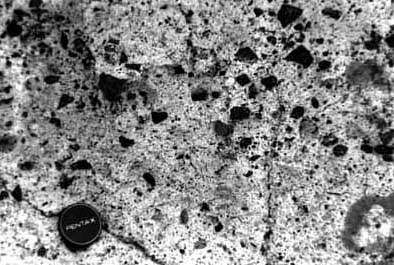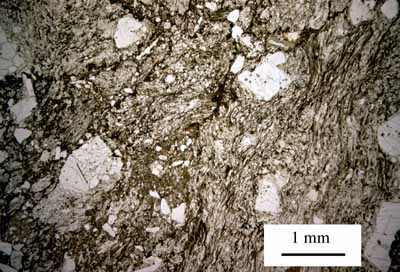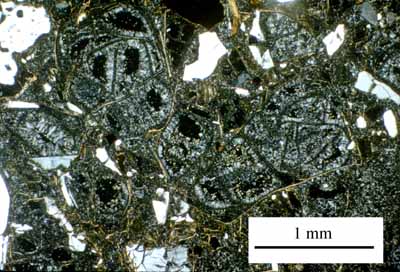 SLIDE 35 shows alkali rhyolite flows, a prominent dark vitrophyre, and
tuff immediately north of the Jerico road.
SLIDE 35 shows alkali rhyolite flows, a prominent dark vitrophyre, and
tuff immediately north of the Jerico road.Flows and stratified tuffs of alkali rhyolite were erupted in the Keg Mountain area at about the same time as in the Thomas Range. The Keg Mountain flows and tuffs are identical in major element composition and mode of eruption to the Topaz Mountain Rhyolite. No fluorite or beryllium-mineralized tuff is known in the Keg Mountain area. The chemical composition of the Keg Mountain tuffs were studied in detail for evidence of mineralization and for diagenetic effects on the mobility of uranium in tuff (Lindsey, 1975b; Zielinski and others, 1980). The geology of the Keg Mountain area is described by Shubat and Snee (1992).
The black and white slides below are of excellent outcrops of alkali rhyolite flows and stratified tuff in the southeastern part of the Keg Mountain area. Rhyolite flows have a dark layer of vitrophyre at the base and have fused the uppermost part of the bedded tuff. Glass in the bedded tuff has been diagenetically altered to the zeolite mineral, clinoptilolite.
 SLIDE 35 shows alkali rhyolite flows, a prominent dark vitrophyre, and
tuff immediately north of the Jerico road.
SLIDE 35 shows alkali rhyolite flows, a prominent dark vitrophyre, and
tuff immediately north of the Jerico road.
 SLIDE 36 shows alkali rhyolite, basal vitrophyre, and stratified tuff
with fused zone at top.
SLIDE 36 shows alkali rhyolite, basal vitrophyre, and stratified tuff
with fused zone at top.
 SLIDE 37 shows a fused tuff. Fused tuff is located immediately below
vitrophyre flow rock and is identical to welded tuff except that it was
formed by heat from the overlying flow. This example of fused tuff shows
the original bedding of the tuff.
SLIDE 37 shows a fused tuff. Fused tuff is located immediately below
vitrophyre flow rock and is identical to welded tuff except that it was
formed by heat from the overlying flow. This example of fused tuff shows
the original bedding of the tuff.
 SLIDE 38 shows tuff with abundant fragments of volcanic rock. Typically,
stratified tuff is composed of abundant pumice and angular fragments of
rhyolite and older volcanic rock. Carbonate clasts are generally absent.
Lens cap shows scale.
SLIDE 38 shows tuff with abundant fragments of volcanic rock. Typically,
stratified tuff is composed of abundant pumice and angular fragments of
rhyolite and older volcanic rock. Carbonate clasts are generally absent.
Lens cap shows scale.
 SLIDE 39 is a thin section (in color) of glassy pumice and shards typical
of unaltered tuff.
SLIDE 39 is a thin section (in color) of glassy pumice and shards typical
of unaltered tuff.
 SLIDE 40 is a thin section (in color) of pumice and shards replaced
by crytals of clinoptilolite and low-temperature cristobalite. These products
of diagenesis are common in tuff of the Keg Mountain area and the Thomas
Range.
SLIDE 40 is a thin section (in color) of pumice and shards replaced
by crytals of clinoptilolite and low-temperature cristobalite. These products
of diagenesis are common in tuff of the Keg Mountain area and the Thomas
Range.